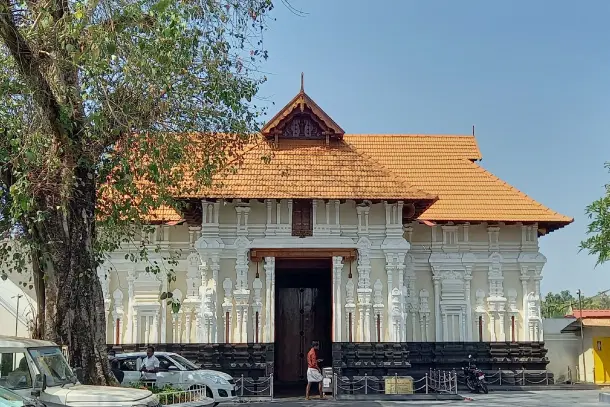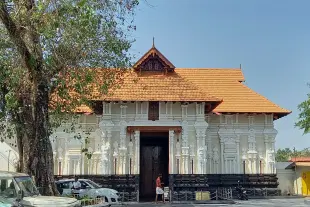Culture
Koodalmanikyam Controversy: Weaving The Garlands Of Vedic Renaissance
Aravindan Neelakandan
Oct 30, 2025, 07:01 AM | Updated Oct 29, 2025, 11:35 PM IST
Save & read from anywhere!
Bookmark stories for easy access on any device or the Swarajya app.


In the precincts of the Koodalmanikyam temple in Thrissur, a dispute over flower garlands has exposed a deep and defining churn within modern Hinduism.
The conflict began with the appointment of K.S. Anurag, a man from the Ezhava community, to a kazhakam position, a traditional role involving ritual assistance, including the preparation of sacred garlands. His selection was not based on lineage but on merit, through the Kerala Devaswom Recruitment Board.
In protest, five of the temple's six chief priests, or Tantris, have refused to perform their duties. Their objection, articulated in a formal letter, is the appointment of staff 'without the knowledge or consent of the temple Tantris', demanding instead 'a qualified person from the traditional family'. For centuries, these roles were the preserve of Ambalavasi families under a system of hereditary rights known as karayma.
Critics are quick to label this a thinly veiled expression of caste prejudice, noting that the alarm over tradition was sounded only when an Other Backward Class (OBC) candidate was selected. The Devaswom Board, for its part, stands by the law, asserting that the 2015 Recruitment Board Act mandates merit-based selection for public posts, superseding older customs.
While the standoff at Koodalmanikyam centres on a garland-maker, it is a symptom of a far more profound and contentious transformation happening at the altar itself: the opening of the priesthood to all castes.
This is not merely a social debate but a fierce legal battle, crystallised in a writ petition currently before the Kerala High Court. In W.P.(C) No. 3994 of 2024, the Akhila Kerala Thanthri Samajam, an organisation of traditional priestly families, has challenged the authority of the state's Devaswom boards to accredit new institutions that train and certify priests (Shanthi).
Their plea is a defence of an ancient system, arguing that only traditional Thanthris possess the spiritual authority to determine who is qualified to perform sacred rites.
At the heart of this challenge is an institution that few outside Kerala have heard of, yet which has quietly engineered this very revolution: the Thanthra Vidya Peedham (TVP).
The Invisible Infrastructure of Reform
Located in Ernakulam, TVP is unremarkable in appearance but revolutionary in purpose. Founded in 1983 by a senior social worker from the Rashtriya Swayamsevak Sangh (RSS), it was established to train priests from all Hindu communities, regardless of caste.
The timing was deeply symbolic, marking the centenary of Sri Narayana Guru, the Advaitic saint who had challenged the birth-based hierarchical establishment a century prior by consecrating temples himself.
The strategic genius of TVP lay not just in its mission, but in its execution.
Working with eminent Vedic scholars, it created a rigorous curriculum covering Vedas, Tantra, and all facets of priestly knowledge. But the masterstroke was securing the endorsement of Sri Jayendra Saraswathi of the Kanchi Kamakoti Peetham, one of Hinduism's most orthodox monastic orders.
Having Kanchi publicly validate caste-blind priestly training was a paradigm shift, reform sanctioned and blessed by orthodoxy itself. It was an approach focussed on fostering harmony-oriented social change rather than stoking conflict.
This work continued patiently, largely invisible to the national media. It was not about agitation but about building capacity. TVP and similar institutions simply created a pool of qualified candidates.
When the Travancore Devaswom Board needed to fill priest positions, TVP representatives sat on the interview board. When the Kerala government made national headlines in 2017 for appointing dozens of priests from Scheduled and Other Backward Classes, it was hailed as a radical act of a progressive government.
The unspoken truth was that the government was drawing from a talent pool that had been painstakingly created over three decades by the very organisations it often opposed.
Liberating Tradition, Not Rejecting It
The prevailing narrative often casts an egalitarian Buddhism against a hierarchical Hinduism. However, a deeper historical analysis suggests that the institutionalisation of untouchability and the defilement of certain occupations were, ironically, accelerated by the rise of Buddhism and Jainism.
Their doctrinal emphasis on absolute non-violence (Ahimsa) and strict moral codes inadvertently stigmatised communities involved in tasks deemed impure.
For instance, early Buddhist texts like the Vinaya Piṭaka explicitly categorise professions such as 'bamboo-plaiter', 'hunter', and even 'flower-sweeper' as 'low birth' (hina jāti). This historical detail directly complicates the Koodalmanikyam dispute.
The insistence on a hereditary, caste-based assignment for a garland-maker or temple cleaner, far from being a uniquely 'Brahminical' imposition, finds an ideological and historical roots in the stratified social worldview of early Buddhism.
This pattern was not confined to ancient India. In Buddhist Myanmar, the lowest social strata were the 'pagoda slaves' (hpaya kyun), outcastes responsible for the upkeep of sacred sites, a role that included tasks like flower scavenging.
These individuals became a hereditary untouchable community, their status justified by Buddhist kings and traditional institutions. This suggests that social stagnation and the marking of certain professions as 'lowly' is a complex phenomenon with multiple historical sources.
In this context, the democratisation of the garland-maker's role is not a break from Vedic Hindu tradition, but a return to a more profound and inclusive Dharmic principle.
It aligns perfectly with the Vedic model of Yajña, which serves as a cosmic archetype where all forms of work, when performed as an offering, become sacred. This framework democratises spirituality and sanctifies all professions, directly opposing the notion of 'defiled' trades.
The powerful Bhakti movements that swept across India are the most potent expression of this liberating impulse, consistently challenging social hierarchies by declaring that a devotee's birth is irrelevant to their spiritual worth.
The move at Koodalmanikyam, therefore, can be seen as a Vedic liberation from a social rigidity that may well have been hardened under a different, non-Vedic influence.
The Path Forward
The standoff at Koodalmanikyam will eventually be resolved.
But the real story is not the conflict, but the quiet, persistent work that made it possible. The debate over hereditary rights versus constitutional equality now exists because, for the first time in centuries, there are qualified candidates from all communities ready to serve.
They exist because a social reformer founded a school, that school trained hundreds of students, and those students became priests, challenging the old order not with slogans, but with competence.
The flower garlands at the temple, whoever strings them, are woven from a new social fabric. That possibility was patiently and fundamentally created in places like Thanthra Vidya Peedham, sustained through decades of quiet conviction.
While some argued about who should serve and others debated whose rights mattered more, a third group simply ensured that all who wished to serve could learn how. The difference between rhetoric and reform often comes down to that choice: to argue about the problem, or to build the solution.
Note: The Judgement can be downloaded here.





